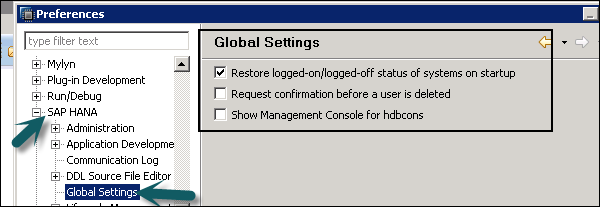
- SAP HANA Admin - Home
- SAP HANA Admin - Overview
- Architecture Overview
- Multitenant Database
- Multiple Host Systems
- Tools
- Cockpit
- Studio
- SAP HANA Admin - System Mngmt
- Multitenant DB Container Mgmt
- Starting a HANA System
- Stopping a HANA System
- License Keys
- Monitoring the HANA System
- SAP HANA Admin - Table Mngmt
- SAP HANA Admin - Table Partition
- SAP HANA Admin - Table Replication
- Data Compression
- Solman Integration
- SAP HANA Admin - Lifecycle Mngmt
- Securing HANA System
- User Provisioning
- Authentication Methods
- Auditing Activities
- Backing Up HANA System
- Recovery HANA System
- HANA XS Application Service
- Data Provisioning
- Smart Data Access
- New Remote System Connection
- Integration with Hadoop
- Key Commands
- Job Responsibilities
SAP HANA Admin - Studio
SAP HANA Studio is an Eclipse-based tool. SAP HANA Studio is both, the central development environment and the main administration tool for HANA system. Additional features are −
It is a client tool, which can be used to access local or remote HANA system.
It provides an environment for HANA Administration, HANA Information Modeling, and Data Provisioning in HANA database.
There are various administration tasks that can be performed using SAP HANA Studio −
- To start and stop service
- To perform monitoring of SAP HANA system
- To perform user management and authorization
- To perform backup and recovery
- To perform Audit policy and Security configuration
- To perform license management
- To perform other configurations in HANA system
- To perform SQL development tasks - HANA Information Models, SQL Stored Procedures
In SAP HANA Studio, you will find a long list of perspectives, which can be considered as separate tools in HANA Studio. All these perspectives can be used for performing various administrative tasks, system monitoring, and data provisioning.
To see list of all Perspectives in HANA Studio, navigate to Window tab → Perspective → Open Perspective → Other.

When you click on Other, it will open the list of all the perspectives that can be used to manage and perform system administration.

SAP HANA Administration Console in HANA Studio
Using this feature, you can open HANA database administration and monitoring features in HANA Studio. By default, it opens in System View.
To open SAP HANA Administration, you can select SAP HANA Administration Console Perspective default option. You can also access it via Administration button at the top.
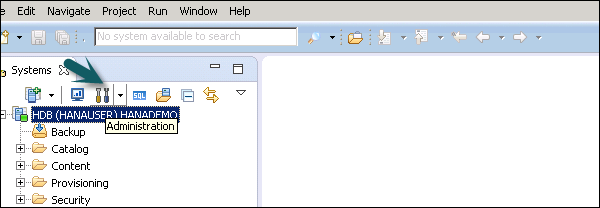
When you click the Administration button as shown in the following screenshot, it opens SAP HANA Administration Console. The console contains all database administration and monitoring features of the SAP HANA studio.

Following tabs are available under SAP HANA Administration Console −
- Overview
- Landscape
- Alerts
- Performance
- Volumes
- Configuration
- System Information
- Diagnosis Files
- Trace Configuration
These tabs are used to perform monitoring and administration tasks in your SAP HANA system.
Adding a System in HANA Studio
Single or multiple systems can be added to HANA Studio for administration and information modeling purposes. To add new HANA system, host name, instance number and database user name and password is required.
- Port 3615 should be open to connect to Database
- Port 31015 Instance No 10
- Port 30015 Instance No 00
- SSh port should also be open
Following are the steps to add a system to HANA Studio.
Step 1 − Right-click the Navigator space and click Add System. Enter HANA system details, i.e. Host name & Instance number and click Next.
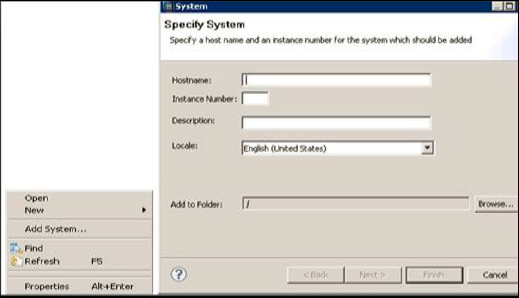
Step 2 − Enter Database user name and password to connect to SAP HANA database. Click Next and then Finish.
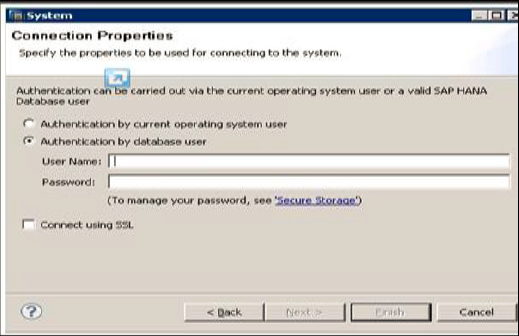
Once you click on Finish, HANA system will be added to System View for administration and modeling purposes. You can see the hierarchical structure of HANA system under HANA Studio.
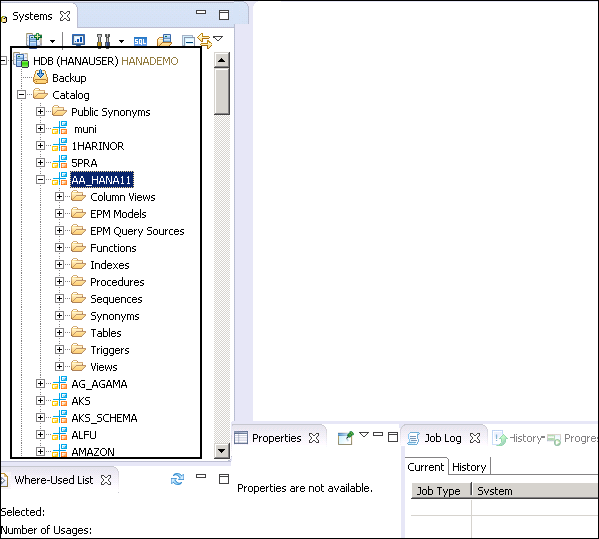
Each HANA system has two main sub-nodes, Catalog and Content.
Catalog Tab − It contains all available Schemas, i.e. all data structures, tables and data, column views, procedures that can be used in the Content tab.
Content Tab − The Content tab contains design time repository, which holds all information of data models created with the HANA Modeler. These models are organized in Packages. The content node provides different views on the same physical data.

Executing SQL Statements in SAP HANA Studio
SQL Console can be opened by selecting the Schema name, in which, a new table has to be created using System View SQL Editor option or by a right-clicking the Schema name as shown in the following screenshot.
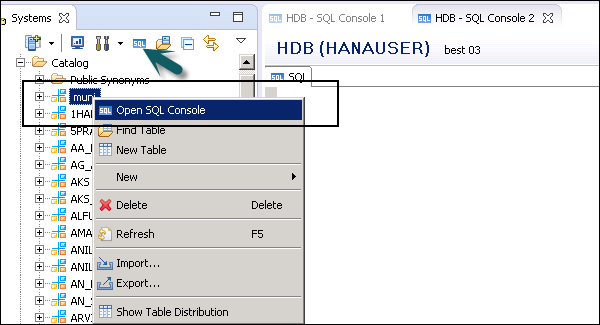
Once SQL Editor is opened, Schema name can be confirmed from the name written on the top of SQL Editor. You can create database objects using SQL statement.
To create a table −
Create column Table Test1 ( ID INTEGER, NAME VARCHAR(10), PRIMARY KEY (ID) );
In this SQL statement, we have created a Column table Test1, defined data types of the table and the Primary Key.
Once you write Create table SQL query, click the Execute option on top of SQL editor on the right side of the screen. Once the statement is executed, we will get a confirmation message as follows −
Statement 'Create column Table Test1 (ID INTEGER,NAME VARCHAR(10), PRIMARY KEY (ID))' successfully executed in 13 ms 761 s (server processing time: 12 ms 979 s) Rows Affected: 0
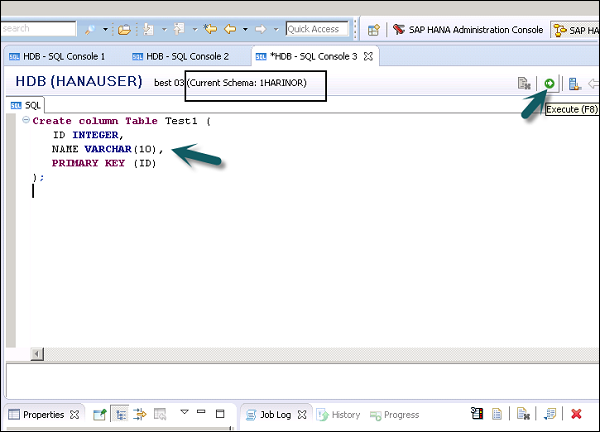
Insert statement is used to enter the data in the Table using SQL editor.
Insert into TEST1 Values (1,'ABCD')
Insert into TEST1 Values (2,'EFGH');
Click Execute.
You can right-click the Table name and use Open Data Definition to see the data type of the table. Open Data Preview/Open Content to see the table contents.
Using Log Off /Log On in SAP HANA Studio
Using SAP HANA Studio, you can also log off from a SAP HANA system and end all the connections. To login to HANA system again, click Logon.
To logoff from a system, right-click the System name in HANA Studio → Log Off.
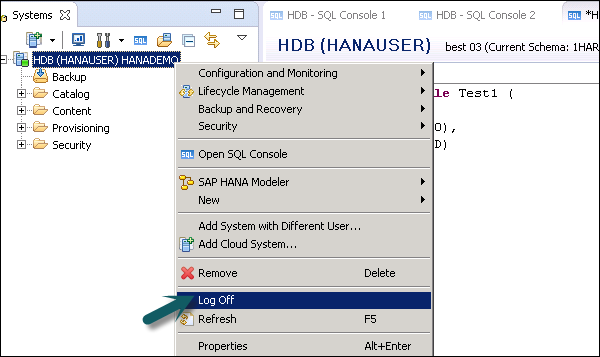
To login again, right-click on HANA system in System Pane → Log On. You will be prompted to enter the password. Enter the password and click OK. You will be logged in to HANA system under HANA Studio. You can view all the folders and objects in HANA system.

You can also define the user logon behavior in SAP HANA Studio startup. It allows you to save the password for the users when HANA Studio or other user settings is open.
Go to Preferences → SAP HANA → Global Settings.

If you wish automatic logon takes place when the Studio is started and also to allow explicit logon when HANA studio starts, uncheck the first option.
